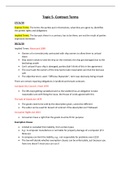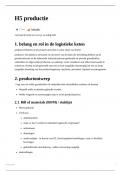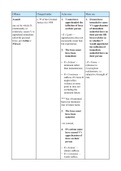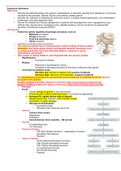MNG3701
Study Pack
, STRATEGIC PLANNING: EXAM REVISION
Learning unit 1
Introduction to strategic management
Define the concept of strategy and briefly explain its relationship to strategic
management. TB p9 /SGp4
Strategy:
- Its generally seen as the result or outcome of fundamentally important pre-emptive,
innovative management decisions about an organisation’s strategic direction and strategic
action plans to attain a sustainable competitive advantage and achieve its long-term
objectives in rapidly changing and competitive external business
- is the direction provided by the actions and decisions of strategists in pursuit of
organisational goals.
-a deliberate choice of activities
-coherent narrative about the future direction of the organisation
-provides members of the organisation with a framework to guide their decision making
-the verbalisation of the organisation’s aspirations and can inspire, unite and motivate
members of the organisation
Explain what is meant by strategic management and discuss the dynamic nature of
the traditional strategic management process. /Define strategy, strategic planning and
strategic management/ Illustrate and explain the strategic management process TB
p3/ SG p6
Strategic management: is a rational approach that organisations use to achieve strategic
competitiveness and competitive advantage. Traditional it draws on the perspective that the
management tasks consists of planning, organising, leading and controlling. Building on this
view, the strategic tasks of top management consist of formulation strategy (planning),
implementing strategy (organising and leading) and control
Strategic management can be looked at from a traditional perspective and in a new
perspective (strategy-as-practice)
The traditional perspective is structured and a process as explained below:
1 Strategy Planning/Formulation-The planning and thinking phase ,where top
management:
Decides on the organisation’s strategic direction and its long-term
objectives(usually found in the vision and mission statement)
1
, Analyses the organisation’s external (to identify opportunities and threats )and
internal environments(to identify best resources and capabilities and the
organisation’s strength and weaknesses)
Selects appropriate competitive strategies strategic choice such as focus,
differentiation or best cost
2 Strategy Implementation/Execution- its the doing part where both human and non-
human factors in the organisation are applied to ensure that the strategy is executed
in line with the devised plans. These are the key elements to be considered:
Leadership and culture- a strategic leader must ensure that the culture of the
organisation is aligned with strategic choice
Implementation competencies- The organisation must ensure that individuals
have the right mix of knowledge, skills and attitudes to support the strategy
Learning organisation-The organisation must be a learning organisation
through its staff and be willing to share knowledge
Systems, policies and procedures- There must be systems such as reward
systems in place to support strategic direction
Organisational architecture and structure- the organisation needs appropriate
structure to successfully execute the strategy
3 Strategic Control
Control measures ensuring that strategies are on track
It reviews and provides feedback to the formulation and implementation
phases
Explain the rationale for new perspectives on strategy/Explain the strategy-as-
practice approach and how it differs from the process approach to strategic
management/Explain strategy-as-practice as an effective approach to managing new
strategic realities.SG p9/TB p7
The new perspective (strategy-as-practice)
Drivers of strategy-as-practice approach have been as follows:
(1) The rise in so-called ‘‘emergent strategies’’, as opposed to the more traditional,
deliberate strategies of organisations, also stemming from rapidly changing business
environments,
(2) The increasing involvement in strategising of people from all levels in the organisation.
Strategies are complex and really address an uncertain future in the sense that
environments are dynamic and changing. Human behaviour also has to be considered.
Apart from new insights and changing environmental conditions, what was actually taught in
strategy did not reflect the realities of business, and this mainly gave rise to the following
realisations about strategy:
2
, Strategy is what people do, not what organisations have-managers, the talk and
documents produced and in their actions
Strategy is not solely the domain of top and executive management—any individual
or group in the organisation that controls key actions can be regarded as a strategist
Strategic management is not a neat and rational process- strategy is emergent rather
than deliberate ,messy rather neat and experimental and filled with failure than
efficient and effective from the start
Strategy is a conversation and involves dialogue and communication- it is about
ideas and choices that are fuelled by both cognitive and political processes. It also
emphasises the importance of conceptual, verbal skills and written documents
Discuss the shortcomings of the traditional process approach to strategic
management and identify the new perspectives on strategic management that have
emerged in response to these shortcomings.SG p28
The traditional process perspective has some criticisms opposed to the new practice
strategy, they are as follows :
It is viewed as a rational and linear process, comprises consecutive phases and does
not effectively embrace new competitive realities.
Because it is a linear process, the effects of the complex, messy and dynamic nature
of the external environment are not fully considered.
Strategy formulation and strategy implementation are seen as separate phases.
It supports the notion that it is only the top management team or senior managers
who develop strategy, thus ignoring potentially valuable contributions by all levels of
staff.
It essentially ignores the development of strategy through dialogue, conversation and
inputs from all organisational levels, and on occasion, external expertise.
Ignores the rise in so-called ‘‘emergent strategies’’, as opposed to the more
traditional, deliberate strategies of organisations, also stemming from rapidly
changing business environments
New perspectives on strategic management
Strategy is what people do, not what organisations have.
Strategy is not solely the domain of top and executive management.
Strategic management is not a neat and rational process.
Strategy is a conversation and involves dialogue and communication.
Explain the different levels of strategy and decision making in organisations/ Describe
the different levels of strategy in organisations SGp14
Level of strategy Corporate entity Single business entity
Corporate Level strategy CEO, board of directors and No corporate strategy exists
Corporate staff. Goal-
Shareholder value
Business level strategy Divisional managers and Executive manager and
3
Study Pack
, STRATEGIC PLANNING: EXAM REVISION
Learning unit 1
Introduction to strategic management
Define the concept of strategy and briefly explain its relationship to strategic
management. TB p9 /SGp4
Strategy:
- Its generally seen as the result or outcome of fundamentally important pre-emptive,
innovative management decisions about an organisation’s strategic direction and strategic
action plans to attain a sustainable competitive advantage and achieve its long-term
objectives in rapidly changing and competitive external business
- is the direction provided by the actions and decisions of strategists in pursuit of
organisational goals.
-a deliberate choice of activities
-coherent narrative about the future direction of the organisation
-provides members of the organisation with a framework to guide their decision making
-the verbalisation of the organisation’s aspirations and can inspire, unite and motivate
members of the organisation
Explain what is meant by strategic management and discuss the dynamic nature of
the traditional strategic management process. /Define strategy, strategic planning and
strategic management/ Illustrate and explain the strategic management process TB
p3/ SG p6
Strategic management: is a rational approach that organisations use to achieve strategic
competitiveness and competitive advantage. Traditional it draws on the perspective that the
management tasks consists of planning, organising, leading and controlling. Building on this
view, the strategic tasks of top management consist of formulation strategy (planning),
implementing strategy (organising and leading) and control
Strategic management can be looked at from a traditional perspective and in a new
perspective (strategy-as-practice)
The traditional perspective is structured and a process as explained below:
1 Strategy Planning/Formulation-The planning and thinking phase ,where top
management:
Decides on the organisation’s strategic direction and its long-term
objectives(usually found in the vision and mission statement)
1
, Analyses the organisation’s external (to identify opportunities and threats )and
internal environments(to identify best resources and capabilities and the
organisation’s strength and weaknesses)
Selects appropriate competitive strategies strategic choice such as focus,
differentiation or best cost
2 Strategy Implementation/Execution- its the doing part where both human and non-
human factors in the organisation are applied to ensure that the strategy is executed
in line with the devised plans. These are the key elements to be considered:
Leadership and culture- a strategic leader must ensure that the culture of the
organisation is aligned with strategic choice
Implementation competencies- The organisation must ensure that individuals
have the right mix of knowledge, skills and attitudes to support the strategy
Learning organisation-The organisation must be a learning organisation
through its staff and be willing to share knowledge
Systems, policies and procedures- There must be systems such as reward
systems in place to support strategic direction
Organisational architecture and structure- the organisation needs appropriate
structure to successfully execute the strategy
3 Strategic Control
Control measures ensuring that strategies are on track
It reviews and provides feedback to the formulation and implementation
phases
Explain the rationale for new perspectives on strategy/Explain the strategy-as-
practice approach and how it differs from the process approach to strategic
management/Explain strategy-as-practice as an effective approach to managing new
strategic realities.SG p9/TB p7
The new perspective (strategy-as-practice)
Drivers of strategy-as-practice approach have been as follows:
(1) The rise in so-called ‘‘emergent strategies’’, as opposed to the more traditional,
deliberate strategies of organisations, also stemming from rapidly changing business
environments,
(2) The increasing involvement in strategising of people from all levels in the organisation.
Strategies are complex and really address an uncertain future in the sense that
environments are dynamic and changing. Human behaviour also has to be considered.
Apart from new insights and changing environmental conditions, what was actually taught in
strategy did not reflect the realities of business, and this mainly gave rise to the following
realisations about strategy:
2
, Strategy is what people do, not what organisations have-managers, the talk and
documents produced and in their actions
Strategy is not solely the domain of top and executive management—any individual
or group in the organisation that controls key actions can be regarded as a strategist
Strategic management is not a neat and rational process- strategy is emergent rather
than deliberate ,messy rather neat and experimental and filled with failure than
efficient and effective from the start
Strategy is a conversation and involves dialogue and communication- it is about
ideas and choices that are fuelled by both cognitive and political processes. It also
emphasises the importance of conceptual, verbal skills and written documents
Discuss the shortcomings of the traditional process approach to strategic
management and identify the new perspectives on strategic management that have
emerged in response to these shortcomings.SG p28
The traditional process perspective has some criticisms opposed to the new practice
strategy, they are as follows :
It is viewed as a rational and linear process, comprises consecutive phases and does
not effectively embrace new competitive realities.
Because it is a linear process, the effects of the complex, messy and dynamic nature
of the external environment are not fully considered.
Strategy formulation and strategy implementation are seen as separate phases.
It supports the notion that it is only the top management team or senior managers
who develop strategy, thus ignoring potentially valuable contributions by all levels of
staff.
It essentially ignores the development of strategy through dialogue, conversation and
inputs from all organisational levels, and on occasion, external expertise.
Ignores the rise in so-called ‘‘emergent strategies’’, as opposed to the more
traditional, deliberate strategies of organisations, also stemming from rapidly
changing business environments
New perspectives on strategic management
Strategy is what people do, not what organisations have.
Strategy is not solely the domain of top and executive management.
Strategic management is not a neat and rational process.
Strategy is a conversation and involves dialogue and communication.
Explain the different levels of strategy and decision making in organisations/ Describe
the different levels of strategy in organisations SGp14
Level of strategy Corporate entity Single business entity
Corporate Level strategy CEO, board of directors and No corporate strategy exists
Corporate staff. Goal-
Shareholder value
Business level strategy Divisional managers and Executive manager and
3










